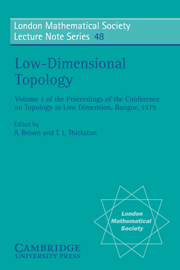The factorisation of knots
Published online by Cambridge University Press: 05 October 2010
Summary
Introduction
It is a well known theorem of Schubert that every classical knot factorises into finitely many irreducible knots, and that this factorisation is unique up to the order of the factors. The first section of the present paper is devoted to a proof of Schubert's result. The proof presented here owes much to a group of topologists gathered at the University of Cambridge in the summer of 1979, and I am grateful to W.B.R. Lickorish for communicating their proof to me.
In higher dimensions, it is a theorem of Sosinskii that for n ≥ 3 every n-knot factors into finitely many irreducibles, and the second section contains an outline of the proof. For n = 3, it is known that the factorisation is not unique, and examples are given in section three of simple 3-knots which factor in more than one way. Finally, for n = 4q – 1, q ≥ 2, uniqueness of factorisation is proved for fibred simple knots whose associated quadratic form is definite.
I know of no results on the factorisation of 2-knots.
Throughout this paper, all theorems are stated for the smooth or piecewise-linear category, and in the latter case all submanifolds are assumed to be locally flat.
The classical case
If k is a classical knot, S1 ⊂ S3, we denote its genus by g(k); that is, the genus of a minimal Seifert surface of k.
- Type
- Chapter
- Information
- Low-Dimensional Topology , pp. 71 - 80Publisher: Cambridge University PressPrint publication year: 1982
- 1
- Cited by

